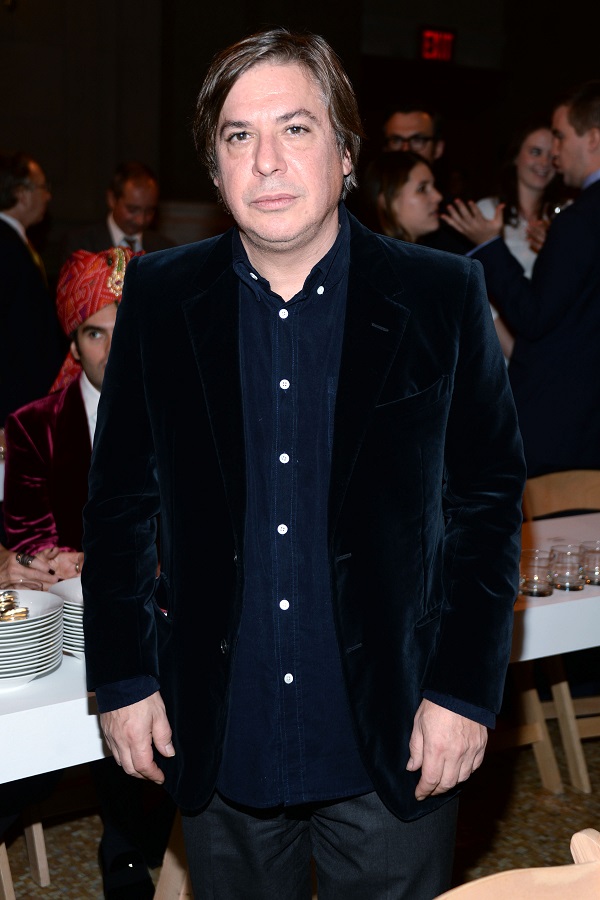On View
Can’t Wait for Michael Flynn’s Trial? Now George Condo Has Painted It in Advance
In the first edition of a new series, we ask the artist about the origin story behind his painting of the former NSA chief.

In the first edition of a new series, we ask the artist about the origin story behind his painting of the former NSA chief.

Julia Halperin

George Condo, whose confounding Cubist-style portraits have landed on Birkin bags and the covers of Kanye West albums, is hardly known for his biting political commentary. But his latest exhibition at Skarstedt Gallery in New York includes The Trial, a painting inspired by the controversy surrounding Michael Flynn, the Trump Administration’s former National Security Advisor who is at the center of the FBI investigation over the campaign’s possible collusion with Russia.
For the first edition of “Origin Story,” a column in which we examine the backstory of an individual work of art, we spoke with the New York-based painter about what drew him to create the work. In the wake of former FBI director James Comey’s testimony this week, the painting takes on added timeliness. Here’s how—and why—Condo made it.

George Condo’s The Trial (2017). Image courtesy of the artist.
Tell me about the origins of The Trial. You were in DC when you came up with the idea for the work, right?
I’d gone down there for my drawings exhibition at the Phillips Collection and I was staying at the Hay-Adams hotel. In the bar area, they had all of these caricatures of politicians all over the walls. I thought of Philip Guston’s caricature of Richard Nixon. And the events in Washington with Michael Flynn happened simultaneously. So I came up with these caricature-like images of Flynn.
You rarely make art that responds to politics. Why now?
I wasn’t really into watching the news over the last five to six years, but ever since the election and all this talk of cyber tampering, I find it really fascinating. When something this complex is happening on a world stage and the entire country’s reputation is at risk—it gives you more reason to express yourself as an artist. Complacency doesn’t really do anything for me.
You said this painting was inspired by caricatures, but this doesn’t look like a straight caricature of Flynn.
Caricatures are fake representations of something real. Among all these ugly men with ties and beady eyes, Flynn is seen a number of times. He’s the one with the really long nose, boiling in this pot of mistrust and ethical transgression. I thought of the Kafka book, The Trial, where nobody knows why [the protagonist] was arrested or who was arresting him. With this guy [Flynn], we don’t know what he did—we can’t figure out what’s real and what’s fake. So it’s less of a caricature and more of a paranoiac painting.
How do you paint paranoia?
I began with something that was a funny face. And then I altered the expression of the eyes, and I repainted the mouth, and, all of a sudden, a funny face turned into a face that was completely horrifying. Then I started to paint imaginary faces that were all equally horrified by some unknown thing taking place around them. It’s a gestural activity with the brush that can turn a face gazing outward into a face gazing inward and projecting outward. It begins with something normal: the expression in the eye, this grimace, the slight opening of the mouth, the beginning of a scream. That’s what generates paranoia.
Most of your portraits are of imaginary figures. Do you approach painting real people differently?
There’s this kind of Trump-like character in the middle with the striped tie, with other guys that look like members of the cabinet. You wouldn’t necessarily say, that guy is Steve Bannon or Jared Kushner. They are the unknown potential scriptwriters behind the scenes—imaginary figures multiplying in Trump’s brain, a chorus guiding him and telling him what to tweet.
What makes good political art?
Jimi Hendrix’s performance of “The Star-Spangled Banner” at Woodstock was so Vietnam that you couldn’t avoid the fact that it was an absolute protest, but at the same time it was a beautiful interpretation of music. Everything was in there—the bombs, the helicopters. A lot of political art—funny paintings of Clinton or Bush—looks dated. If they capture a sense of paranoia or oppression or freedom, those images become locked in our minds.
“Origin Story” is a column in which we examine the backstory of an individual work of art.
“George Condo: New Works” is on view at Skarstedt, 20 East 79th Street, New York, April 27–June 24, 2017.